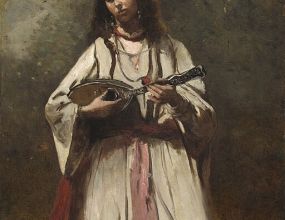 Source: Wikimedia Commons
Source: Wikimedia Commons In the 18th and 19th centuries, Roma people aroused great interest in European society. Their nomadic lifestyle, exotic culture and mystery have been a source of inspiration for many artists, writers and musicians. Roma were often portrayed as freedom-loving and independent people living in harmony with nature, but also as representatives of an alien and incomprehensible life, which gave rise to myths and stereotypes. The painting "Gypsy Woman with Mandolin" by Jean-Baptiste Camille Corot is an embodiment of everything described.
In the 18th and 19th centuries, Roma people aroused great interest in European society. Their nomadic lifestyle, exotic culture and mystery have been a source of inspiration for many artists, writers and musicians. Roma were often portrayed as freedom-loving and independent people living in harmony with nature, but also as representatives of an alien and incomprehensible life, which gave rise to myths and stereotypes.
Romanticism in art was a movement that emerged in the late 18th century and reached its peak in the mid-19th century. This movement emphasized emotional expressiveness, individuality and nature. Romantic artists often sought inspiration in exotic and folk themes, seeking to convey feelings and subjective experiences.
The nomadic lifestyle of Roma, their refusal of a sedentary existence and the rules of traditional society, was perceived as an expression of maximum freedom. This stereotype emphasized their independence and ease, contrasting them with the rigid social structures of European society. During that period, artists turned to themes of nature, exoticism, historical events and folk legends. In this context, Roma became a symbol of freedom, passion and naturalness, which attracted many romantic artists looking for inspiration in unusual and dramatic subjects.
Jean-Baptiste Camille Corot (1796-1875) is a French artist whose work occupies a special place in the history of art. He was a master of landscape painting and genre scenes. Corot was influenced by Romanticism, but his work also anticipated Impressionism through its use of light and color. He strived to convey the atmosphere and mood of his scenes, paying great attention to detail and emotion.
The painting "Gypsy Woman with Mandolin", painted in 1870, is a striking example of Corot's ability to combine realism with the poetic atmosphere inherent in his style. The canvas depicts a young Roma woman, a lonely figure, immersed in quiet thoughts. A sad look to the side, the image of smooth touches on the strings of the mandolin create the impression that the woman paused in the shimmering melody and was thinking about something of her own. It gives this piece of art a depth of storytelling. Simple but colorful clothes: a white blouse with embroidery, a bright red skirt visible under a faded apron, and modest jewelry - a necklace and a headband - emphasize her folk identity. The smoothness of the strokes, the vagueness of the details, the delicate palette of colors focuses all the attention on Roma herself, her face, which is drawn most clearly, the textural contrasts of the outfit and the shine of the mandolin. The Roma is depicted against a background of nature, which emphasizes her connection with the natural world and symbolizes freedom. The soft and warm colors used by Corot create warmth and humanity in the image. The dark tones of the very image of Roma and its background give the picture a flair of mysticism, which is quite comparable to the image of Roma in the eyes of people – mystery, which was and remains the main companions of Roma.
Although there are no specific documented contacts between Corot and the people, his interest in ethnographic and genre scenes probably prompted the artist to depict the Roma woman. During the Romantic era, to which Corot belonged, Roma people were often seen as symbols of freedom and exoticism. This coincided with his desire to convey a special atmosphere and rich emotions in his canvases.
Despite the fact that Corot conveyed an image of Roma based on cultural stereotypes, there are also elements of reality in it. The people indeed often performed at fairs and festivals, playing musical instruments and dancing. However, in everyday life their clothing was more practical. The bright costumes and romantic aura inherent in the picture more likely reflect society's idealized ideas about Roma than real life.
The painting " Gypsy Woman with Mandolin" by Jean-Baptiste Camille Corot is a wonderful example of art of the 19th century. It reflects both the romantic ideals of freedom and passion, as well as the cultural stereotypes about Roma that existed at the time. Corot's work allows us to better understand how artists of that period perceived and depicted representatives of mysterious and vibrant Roma culture. The study of such works helps to penetrate deeper into the cultural and historical contexts of past centuries and appreciate the diversity of artistic interpretations of the Roma theme.